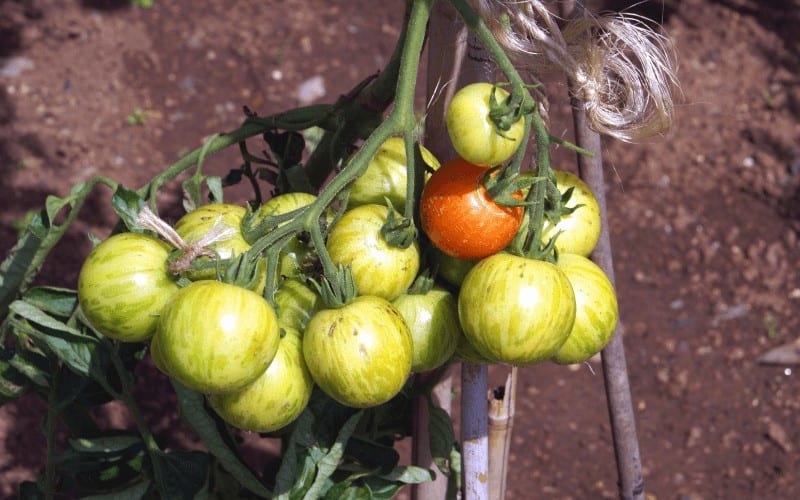Growing plants upside down might sound like an absurd concept, isn’t it? But funny enough, this isn't a new or ridiculous concept. The inverted tomato system has been in the market for quite some time.
As a new gardener, it's normal to wonder what happens if you grow a plant upside down. Will the plants thrive and survive? The simple answer to the question is that plants can be grown upside down.
Gravity will still affect plants that are grown upside down, and the roots will turn and twist to extend towards the ground.
This post will provide information on all you need to know about growing a plant upside down and plants that can be grown upside down.
Table of Contents
What Happens If You Grow A Plant Upside Down?
Growing a plant upside down does not mean that the plants' roots will hang in the air. You must have it in mind that gravity affects everything, and as such, the roots will still twist until they find soil.
Ideally, plants are designed to grow with their roots in the ground and their stems pointing to the sun. Growing plants upside-down may require the plant to put in extra energy in righting itself and determining the sun's direction.
Why Do Gardeners Grow a Plants Upside Down?
There are lots of reasons why gardeners may decide to grow their plants upside down. The concept was first tried by a gardener, Kathi Lael Morris, on peppers and tomatoes. Following the success of the procedure, growing plants upside down became the new trend.
Apart from being a new trend, it was discovered that planting upside down has many benefits, such as:
- Deter some pests and, in the long run, prevents many fungal diseases
- Save space; if you have a small garden, then you should consider upside-down planting
- You will get a healthy and flourishing plant since water and nutrients are efficiently delivered to the roots
- Reduces the need to stake or cage
- Increases light exposure and allows for more excellent air circulation
Pitfalls of Growing Plants Upside Down
Admittedly, there are lots of benefits of growing plants upside down. But these benefits come with their attendant cons. Many gardeners hold the view that growing plants upside down is not exactly practical.
Having in mind that gravity plays a role in the growth of a plant, plants that bear plump fruits might not be suitable for upside-down planting. Weight issues may account for why upside-down planting is more commonly used with cherry or grape tomato varieties.
Upside down planting requires additional fertilizers and water to thrive efficiently. For instance, in tomato plants, the root balls are exposed to wind and sunlight, requiring you to water the plant frequently.
Not all crops can be planted upside down; it follows that upside-down planting limits the type of crops you want to grow.
Plants like tomatoes produce hormones called auxins which drive stem growth. The hormones cause the tips of the branches to turn upward towards the light.
How to Grow Plants Upside Down
If you are curious about how growing plants upside down works, nothing stops you from trying it out. But first and foremost, you will need to visit your favorite gardening shop for the items outlined below:
- A strong hook
- Strong string or metal wire
- A 7.5cm (six-inch) circle of foam or sponge
- Lightweight soil or compost
- A large bucket
- A sharp knife
- A marker pen
- A tray to catch water
- A young plant
Once you have these items in your custody, you can proceed with planting.
- Locate a sunny spot in your home and mark the ceiling where the pots will be,
- Install the hook,
- Make a hole in the bottom of the bucket just large enough to push the plant through.
- Fill the bucket with moist soil and then push in the plant and hang the container from the handle on your hook.
- Place the water catcher beneath the bucket,
- Always water the plant and avoid the soil from going dry.
Plants That Can Grow Upside Down
Before attempting upside planting, you must have it in mind that not all plants thrive when planted upside down. Some plants that can be grown upside down are:
- Vegetables like peppers, tomatoes, Japanese eggplant, zucchini, summer squash, and bush beans
- Fruits like strawberries and grapes
- Herb plants like basil, parsley, and lemon verbena. Creeping herb plants, like oregano and creeping thyme, also do well when grown upside down.
Conclusion
As mentioned earlier, growing plants upside down is not a new or absurd concept. The whole essence of gardening is food provision.
Upside down, farming has proven to be quite useful to those of us who live in apartments but still have a knack for gardening. With the knowledge obtained from this post, you can confidently answer what happens if you grow a plant upside down.






